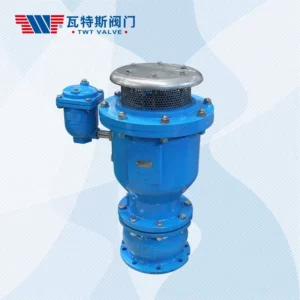Using cast iron as the primary material for manufacturing air valves offers several advantages, making it a popular choice for various applications in water distribution and other industries. Some of the key advantages include:
- Durability: Cast iron is known for its exceptional durability and long service life. It can withstand harsh environmental conditions, including exposure to water, chemicals, and extreme temperatures, without corroding or deteriorating.
- Strength: Cast iron is a strong and robust material, making it suitable for applications where structural integrity and resistance to mechanical stress are important. It can handle high pressures and loads.
- Resistance to Corrosion: Cast iron has natural resistance to corrosion, particularly when it’s used for air valves in water distribution systems. This resistance to corrosion is crucial for maintaining the integrity of the valve over time.
- Chemical Compatibility: Cast iron is compatible with various fluids and chemicals commonly found in water distribution systems, which is essential for maintaining the functionality of air valves in such applications.
- Low Maintenance: Cast iron air valves require minimal maintenance. Their durability and resistance to corrosion mean they have a longer service life with fewer repair and replacement needs, reducing maintenance costs.
- Sealing Capabilities: Cast iron can be effectively machined to create precise sealing surfaces, ensuring airtight operation. cast iron air valve This sealing capability is crucial for the performance of air valves.
- Versatility: Cast iron air valves are versatile and can be used in a wide range of applications, including water supply networks, wastewater systems, and industrial processes.
- Cost-Effectiveness: While cast iron may have a higher initial cost compared to some other materials, its long service life and low maintenance needs make it cost-effective over the life of the valve.
- Fire Resistance: Cast iron is inherently fire-resistant, making it suitable for applications where fire safety is a concern.
- Noise Reduction: The density of cast iron helps dampen vibration and reduce noise, making it suitable for applications where quiet operation is important.
- Environmental Sustainability: Cast iron is a recyclable material, contributing to its environmental sustainability. It can be recycled and used in the production of new cast iron products.
- Standardization: Cast iron air valves are often manufactured according to established standards and specifications, ensuring consistency and compatibility with existing systems.
- Proven Performance: Cast iron air valves have a long history of successful performance in various industries and applications, demonstrating their reliability.
In summary, cast iron offers a combination of durability, strength, resistance to corrosion, and low maintenance, making it an advantageous material for manufacturing air valves. These qualities ensure the longevity and reliability of air valves in critical applications such as water distribution systems.
What role does a cast iron air valve play in preventing air pockets, vacuum conditions, and water hammer in pipelines?
A cast iron air valve plays a crucial role in maintaining the efficient and safe operation of pipelines by preventing or mitigating three common issues: air pockets, vacuum conditions, and water hammer. Here’s how it addresses each of these challenges:
- Preventing Air Pockets:Cast iron air valves are equipped with a float mechanism or a similar design that allows them to automatically expel trapped air or gases from the pipeline. This is important because the presence of air pockets in pipelines can lead to several problems, including reduced flow capacity, increased energy consumption, and the potential for localized pressure fluctuations. The air valve releases the accumulated air, ensuring that the pipeline remains filled with the intended fluid, whether it’s water, sewage, or another fluid. This promotes the efficient and consistent flow of the liquid.
- Avoiding Vacuum Conditions:Cast iron air valves are designed to prevent vacuum conditions within the pipeline. When fluid flows through the pipeline, especially in downhill or rapidly descending sections, it can create a vacuum if there’s insufficient air venting. This vacuum can cause the pipeline to collapse or deform, leading to damage and operational issues. Air valves are strategically placed in the pipeline to allow air to enter when needed, preventing the formation of a vacuum and maintaining the structural integrity of the pipeline.
- Mitigating Water Hammer:Water hammer occurs when there are rapid changes in fluid flow or direction, such as sudden valve closures or pump starts and stops. This can result in the generation of pressure waves within the pipeline, which can lead to damage, leaks, and operational disruptions. Cast iron air valves, when properly installed and maintained, can help alleviate water hammer by allowing pressure fluctuations and waves to dissipate. They serve as relief points for excess pressure, reducing the risk of damage to the pipeline and associated components.
Cast iron air valves are strategically located at high points and other critical locations in the pipeline to ensure effective air and vacuum release and mitigate the potential for water hammer. Their automated operation and reliability make them valuable components in maintaining pipeline efficiency and safety, particularly in water supply systems, wastewater systems, and industrial applications where these issues can be of significant concern.
